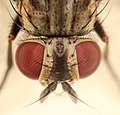Housefly
Housefly is a common insect that belongs to the family Muscidae. It is known for its ubiquity, being found in nearly all parts of the world, and its close association with human habitation. The housefly is considered a pest due to its role in the transmission of diseases.
Description[edit]
The housefly is a medium-sized fly, typically 6-7 mm in length. It has a grey thorax with four longitudinal dark lines. The abdomen is yellowish at the base, becoming darker towards the end. The housefly has large compound eyes, which give it a wide field of vision.
Life Cycle[edit]
The life cycle of the housefly consists of four stages: egg, larva, pupa, and adult. The female housefly lays her eggs in decaying organic matter, such as food waste or feces. The eggs hatch into larvae, or maggots, which feed on the decaying matter. After a period of growth, the larvae pupate. The adult flies emerge from the pupae and the cycle begins again.
Behavior[edit]
Houseflies are active during the day and rest at night. They are attracted to a wide range of substances, including human food, garbage, and feces. Houseflies feed by regurgitating digestive juices onto their food, then sucking up the resulting liquid.
Disease Transmission[edit]
Houseflies are known to transmit a number of diseases, including typhoid, cholera, dysentery, and tuberculosis. They can pick up disease-causing organisms while feeding or laying eggs, then transfer them to human food or surfaces.
Control[edit]
Control of houseflies typically involves a combination of sanitation, exclusion, and direct control methods. Sanitation involves removing potential breeding sites, while exclusion involves preventing flies from entering buildings. Direct control methods include the use of insecticides and fly traps.
See Also[edit]
Ad. Transform your life with W8MD's Budget GLP-1 injections from $75


W8MD offers a medical weight loss program to lose weight in Philadelphia. Our physician-supervised medical weight loss provides:
- Weight loss injections in NYC (generic and brand names):
- Zepbound / Mounjaro, Wegovy / Ozempic, Saxenda
- Most insurances accepted or discounted self-pay rates. We will obtain insurance prior authorizations if needed.
- Generic GLP1 weight loss injections from $75 for the starting dose.
- Also offer prescription weight loss medications including Phentermine, Qsymia, Diethylpropion, Contrave etc.
NYC weight loss doctor appointmentsNYC weight loss doctor appointments
Start your NYC weight loss journey today at our NYC medical weight loss and Philadelphia medical weight loss clinics.
- Call 718-946-5500 to lose weight in NYC or for medical weight loss in Philadelphia 215-676-2334.
- Tags:NYC medical weight loss, Philadelphia lose weight Zepbound NYC, Budget GLP1 weight loss injections, Wegovy Philadelphia, Wegovy NYC, Philadelphia medical weight loss, Brookly weight loss and Wegovy NYC
|
WikiMD's Wellness Encyclopedia |
| Let Food Be Thy Medicine Medicine Thy Food - Hippocrates |
Medical Disclaimer: WikiMD is not a substitute for professional medical advice. The information on WikiMD is provided as an information resource only, may be incorrect, outdated or misleading, and is not to be used or relied on for any diagnostic or treatment purposes. Please consult your health care provider before making any healthcare decisions or for guidance about a specific medical condition. WikiMD expressly disclaims responsibility, and shall have no liability, for any damages, loss, injury, or liability whatsoever suffered as a result of your reliance on the information contained in this site. By visiting this site you agree to the foregoing terms and conditions, which may from time to time be changed or supplemented by WikiMD. If you do not agree to the foregoing terms and conditions, you should not enter or use this site. See full disclaimer.
Credits:Most images are courtesy of Wikimedia commons, and templates, categories Wikipedia, licensed under CC BY SA or similar.
Translate this page: - East Asian
中文,
日本,
한국어,
South Asian
हिन्दी,
தமிழ்,
తెలుగు,
Urdu,
ಕನ್ನಡ,
Southeast Asian
Indonesian,
Vietnamese,
Thai,
မြန်မာဘာသာ,
বাংলা
European
español,
Deutsch,
français,
Greek,
português do Brasil,
polski,
română,
русский,
Nederlands,
norsk,
svenska,
suomi,
Italian
Middle Eastern & African
عربى,
Turkish,
Persian,
Hebrew,
Afrikaans,
isiZulu,
Kiswahili,
Other
Bulgarian,
Hungarian,
Czech,
Swedish,
മലയാളം,
मराठी,
ਪੰਜਾਬੀ,
ગુજરાતી,
Portuguese,
Ukrainian













